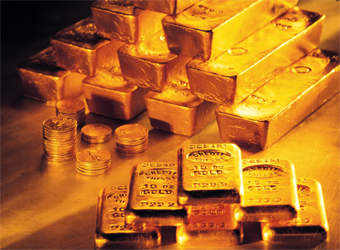Gold hit on Friday a two-week high amid a weaker dollar and was set to end 2016 more than 9 percent higher, snapping three years of drops.
Spot gold was down 0.6 percent at $1,151.91 an ounce, having hit its highest since Dec. 14 at $1,163.14.
U.S. gold futures for February delivery settled to $1,151.70 an ounce.
In the first half of 2016, investors increased gold exposure as the Federal Reserve showed caution on raising interest rates due to concerns about global growth, while Britain’s vote to leave the European Union curbed appetite for risk and pushed the metal to a two-year high in July.
But gold prices fell more than 8 percent in November, on higher U.S. Treasury yields after Donald Trump’s election win led to speculation his commitment to infrastructure spending would spur growth.
Bullion then hit a 10-month low on Dec. 15 as solid U.S. economic data gave the Fed the confidence to raise rates for the first time in a year. The central bank signalled three more increases next year from the previous projection of two.
“In 2017, we could see more weakness in the gold price because of the three projected rate increases by the Fed, which would lead to a stronger dollar,” said Peter Fertig, owner of Quantitative Commodity Research.
“On the other hand, though, uncertainty about political alliances between U.S. President-elect Trump and international players could create some geopolitical fractures, which would be positive for gold.”
The precious metal is often seen as a hedge against geopolitical risks.
The dollar, which was down 0.5 percent against a basket of six currencies, and U.S. Treasury yields will remain a key driver for gold’s movements, analysts said.
Returns from U.S. bonds are closely watched by the gold market, given that the metal pays no interest.
Other precious metals were also set to end the year in positive territory, with palladium the best performer, up more than 19 percent so far in 2016. It was unchanged at $671.84 an ounce.
Platinum gained 0.4 percent to $901, heading for a yearly rise of just over 1 percent, its first annual gain in four years.
The spread between platinum and palladium contracted to its narrowest in nearly 15 years earlier this month at $141 an ounce, as palladium, mostly used in autocatalysts, benefited from higher car demand in China and the United States and dwindling supply.
“A sharply widening deficit … is likely to propel palladium higher as scope for mine output remains limited and industrial and auto demand firm,” HSBC said in a note.
Silver, up 0.2 percent at $16.18, was on track to end the year 17 percent higher.
Source: Reuters



